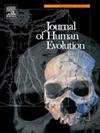另外对牙根和类人猿牙齿形态的分析支持Kapi ramnagarensis是一种牙根虫
IF 3.1
1区 地球科学
Q1 ANTHROPOLOGY
引用次数: 0
摘要
长臂猿化石极为罕见,有许多舌足类化石记录,因此,舌足类的进化史仍然未知。根据印度Ramnagar (J&;K)周围约13.0-12.5 Ma沉积物中孤立的右下方M3, Kapi ramnagarensis被描述为茎状水螅体。这一解释最近受到了挑战,有其他假说认为,它是一种茎卡塔林或一种奇怪的衍生上棘类,在水螅体形态上趋同。一系列的形态特征被认为将卡皮与化石和现存的水螅虫区分开来;然而,值得注意的是,这些特征都没有使用定量分析进行检查或比较。在这里,我们进一步研究了Kapi的牙齿形态,提供了定量分析,以批判性地评估Kapi代表茎卡塔林或上棘类而不是茎棘类的假设。结果表明,在更仔细的审查下,Kapi和舌裂体之间所声称的差异都不成立,考虑到大小和形状的多变量判别分析强烈支持Kapi作为具有高后验概率的舌裂体。虽然只有一颗下臼齿,但卡皮仍然是化石记录中已知最早的舌足最有说服力的候选者,因此可能证明了中新世中期小猿和大猿同时到达亚洲。本文章由计算机程序翻译,如有差异,请以英文原文为准。
Additional analyses of stem catarrhine and hominoid dental morphology support Kapi ramnagarensis as a stem hylobatid
Fossil gibbons are exceedingly rare, with much of the hylobatid fossil record and, consequently, hylobatid evolutionary history remaining unknown. Kapi ramnagarensis was described as a stem hylobatid on the basis of an isolated lower right M3 from ∼13.0–12.5 Ma deposits surrounding Ramnagar (J&K), India. This interpretation was recently challenged, with alternative hypotheses suggesting that it is instead a stem catarrhine or a strangely derived pliopithecoid that has converged on hylobatid morphology. A series of morphological features were said to distinguish Kapi from fossil and extant hylobatids; notably, however, none of these features were examined or compared using quantitative analyses. Here, we further examine the dental morphology of Kapi, providing quantitative analyses to critically evaluate the hypothesis that Kapi represents a stem catarrhine or pliopithecoid rather than a stem hylobatid. Results demonstrate that none of the claimed differences between Kapi and hylobatids hold up under closer scrutiny, and multivariate discriminant analyses taking size and shape into account strongly support Kapi as a hylobatid with high posterior probabilities. Although only represented by a single lower molar, Kapi remains the most compelling candidate for the earliest known hylobatid in the fossil record and thus likely documents the simultaneous arrival of lesser and great apes to Asia during the Middle Miocene.
求助全文
通过发布文献求助,成功后即可免费获取论文全文。
去求助
来源期刊

Journal of Human Evolution
生物-进化生物学
CiteScore
6.30
自引率
15.60%
发文量
104
审稿时长
3 months
期刊介绍:
The Journal of Human Evolution concentrates on publishing the highest quality papers covering all aspects of human evolution. The central focus is aimed jointly at paleoanthropological work, covering human and primate fossils, and at comparative studies of living species, including both morphological and molecular evidence. These include descriptions of new discoveries, interpretative analyses of new and previously described material, and assessments of the phylogeny and paleobiology of primate species. Submissions should address issues and questions of broad interest in paleoanthropology.
 求助内容:
求助内容: 应助结果提醒方式:
应助结果提醒方式:


